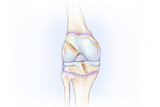Anterior Cruciate Ligament (ACL) Injury: Aliyah's Story
Anterior Cruciate Ligament (ACL) Injury: Aliyah's Story
Aliyah has been a gymnast since the age of 3. She’s spent most of her life jumping, tumbling and flipping, typically training for four hours a day, five days a week, almost 51 of the 52 weeks in a year.

By her junior year of high school, she was already a two-time Junior Olympics state champion and a record holder on her favorite exercise: the floor. But early that year, just as a number of colleges began showing interest in recruiting her for their gymnastics programs, she suffered an injury dismounting from the balance beam during practice.
“My upper body kept twisting but my legs stopped, so it caused my legs to hyperextend,” says Aliyah. “I didn’t hear the pop, but everyone else did, and then I collapsed.”
The pain was immediate. Aliyah couldn’t straighten or put any pressure on her left leg and had to be carried off the mat. Her father brought her to the emergency room at Virtua Voorhees hospital in Voorhees, N.J. There, an MRI confirmed she had torn her anterior cruciate ligament (ACL). The ACL is one of the four main ligaments in the knee and provides most of the leg’s stability, allowing for rotational movement of the knee.
What are the odds of tearing your ACL? Estimate your risk >
A torn ACL used to be a devastating injury to an athlete. Today, with surgery and proper rehab, most athletes can return to their sport. Anterior cruciate reconstruction involves surgical arthroscopy, a minimally invasive procedure that uses small incisions to minimize trauma to the knee. A new ligament is used to replace the torn one. It is an extremely technical procedure that should be performed by an experienced sports orthopedist who performs the surgery often and is familiar with the injury. Proper physical therapy often requires close to a year to regain motion and strength in the knee.
Finding experts in ACL repair for teen athletes
The doctors at Virtua referred Aliyah to Lawrence Wells, MD, an attending orthopedic surgeon with Children’s Hospital of Philadelphia (CHOP). Dr. Wells has special expertise in surgical repair of sports-related ACL injuries. He confirmed the diagnosis and recommended surgery, with an eye to getting Aliyah back to gymnastics and her active lifestyle as soon as possible.
Dr. Wells reconstructed Aliyah’s ACL close to her family’s home at the CHOP Specialty Care Center and Ambulatory Surgery Center in Voorhees. Shortly after surgery, Aliyah began physical therapy at CHOP’s Sports Medicine and Performance Center located within Virtua Voorhees. The Sports Medicine and Performance Center is a premier healthcare resource for young athletes. Aliyah had twice weekly sessions with sports physical therapist Ken Knecht, PT, MS, SCS, CSCS, who has experience working with collegiate and professional athletes. Her rehabilitation began with heel bends, toe raises, hamstring stretches, muscle tightening exercises and balancing on a board.
“I had doubts,” Aliyah recalls. “Especially after surgery. During the recovery process it goes from ‘You’re doing great’ to ‘Wait, you took two steps backwards.’ But the doctors told me not to worry. Before he gave me the surgery, Dr. Wells said, ‘You’re going to come back, you’ll be fine. I expect to see you at championships,’ so that gave me some relief that my doctor had my back.”

ACL Surgery: Where You Go Matters
ACL surgery in a child or teen should account for the fact that bones are still growing. Learn why from CHOP’s experienced team.
Returning to competitive sports after ACL surgery
The injury had sent most recruiters running, except for the gymnastics coach at Alderson Broaddus University, a private four-year university in West Virginia. She said as long as Aliyah could show full recovery before freshman year, she had a spot on the team.
That was all the motivation Aliyah needed. One month post-surgery, she was able to walk on her leg with the help of crutches. Three months post-surgery, she ditched the crutches entirely. She was able to run on a treadmill about five months after surgery, and after seven months was sprinting and doing one-legged squats and lunges with dumbbells. She even began light gymnastics activity like jumping and tumbling. Finally, after nine long months of PT, Aliyah was cleared to get back in the gym at 100 percent.
She had just three months to train, yet still managed to make it to the New Jersey State Championship. Exactly one year to the day after her surgery, she won the New Jersey State Championship on the floor exercise, scoring a 9.20. That score, along with her 9.00 on the vault, earned her a spot to compete at the Junior Olympic Level 9 Regionals in Virginia a month later. She placed fourth on floor out of 7,000 gymnasts from Delaware, Maryland, New Jersey, Pennsylvania, Virginia and West Virginia.
Overjoyed and incredibly grateful for her team at CHOP, she gave her state championship medal to Dr. Wells and her regional medal to Ken.
“I love Dr. Wells and Ken. They helped me get back to where I was if not better and prove to my college coach that she could put her trust in me to be on the team,” says Aliyah, who will be attending Alderson Broaddus on an athletic scholarship for acrobatics and tumbling, and plans to pursue a degree in nursing. “It was amazing. I feel total confidence in my leg.”
“Aliyah was a model patient,” says Wells. “Despite her season-ending injury, she maintained her resolve, worked diligently and endured the hard rehab to get back her high performance capabilities. We at CHOP are elated with her recovery and her accomplishments. I feel honored to have been her surgeon and the recipient of her gold medal.”